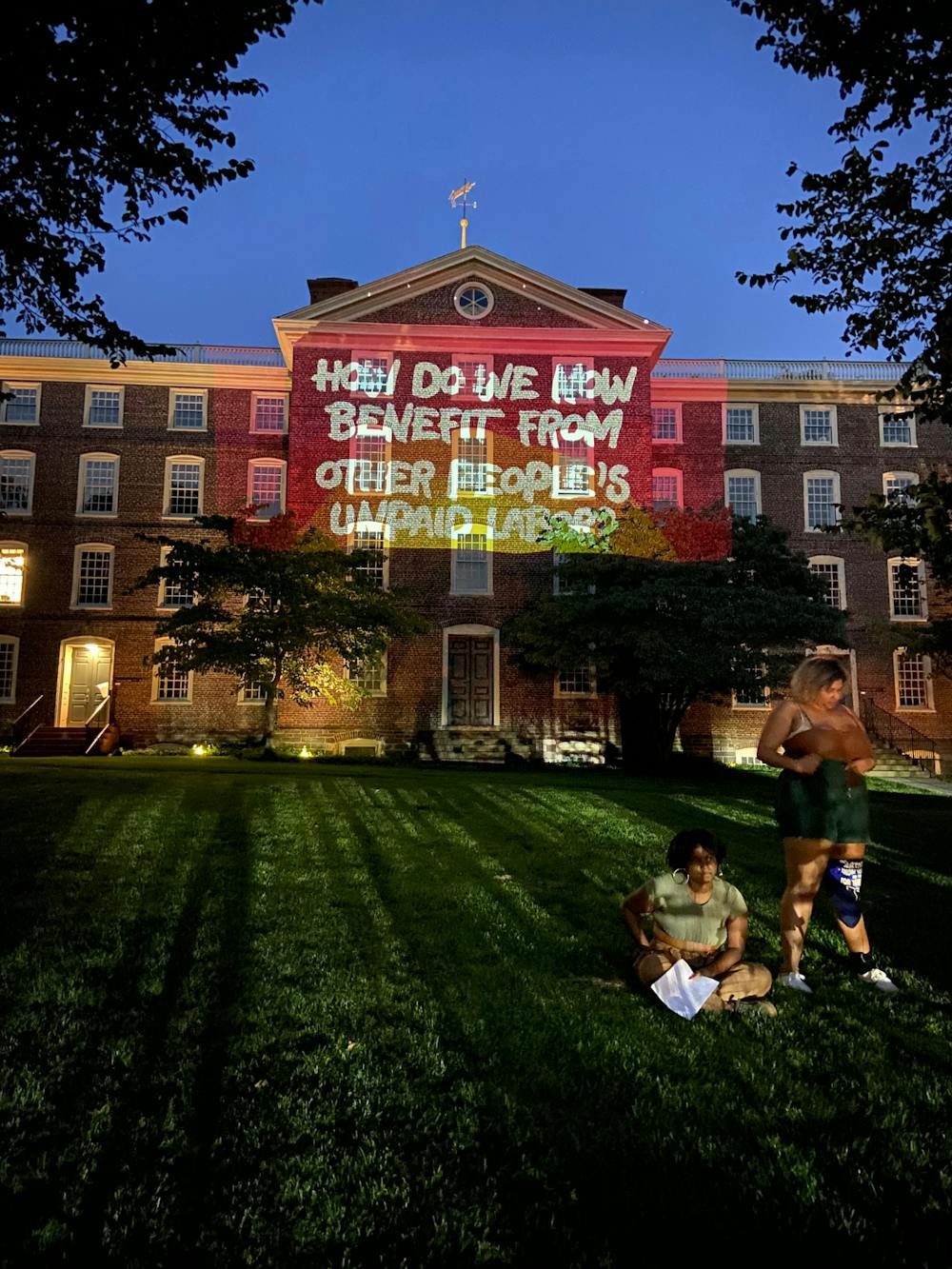In recognition of the International Day for the Remembrance of the Slave Trade and its Abolition, local non-profit The Womxn Project held a three-part light projection public art series titled “Illuminating the Legacy of Slavery in Rhode Island.”
The series aimed to raise awareness about Rhode Island’s historical ties to slavery and “motivate attendees to work toward an anti-racist future” through illuminated artwork and public performances, including a display at Brown’s own University Hall, according to The Womxn Project website.
In 2020, The Womxn Project held light projection displays to support the Black Lives Matter movement and encourage voting in the presidential election. The 2021 series, described as “artivist projections,” engage with the public “as pop-up art events with an educational purpose,” Cristina DiChiera, series co-creator and board member at The Womxn Project Education Fund, wrote in an email to The Herald.
“With grant support from the RI Council of the Humanities and RI State Council on the Arts, (The Womxn Project Education Fund) brought together artists and scholars to create narratives based on research, while performers are working with creative writers to bring original reads to each site-specific location,” The Womxn Project website read.
A team of around 20 scholars, artists and writers worked on the project, according to DiChiera.
“Our projects are meant to evoke a response or to shed light on topics that we, as a group, think are important,” DiChiera wrote.
The display at University Hall included the visual art projection along with a script entitled “More Sugar” written by Marlon O’Cary, Providence-based poet and performer, and read by theatrical performer Catia Ramos, an artist-in-residence at Rhode Island Latino Arts.
The script gives a “deeply emotional exploration” of Rhode Island’s association with the slave trade, DiChiera wrote. In the performance, Ramos noted that “over 1,000 slave voyages departed from Rhode Island ports.”
The Providence visual art display, projecting words that read, “Who profits from the labor put into these buildings?” and “How do we now benefit from other people’s unpaid labor?” was designed by illustration artist and designer Devon Blow.
Ramos’ reading of “More Sugar” highlighted the Rhode Island economy’s heavy and brutal reliance on state plantations exploiting the labor of enslaved people for commodities such as sugar and rum. “Life on the island plantations was horrendous and the life expectancy was less than seven years,” Ramos read.
The series took place Aug. 23, Aug. 30 and Sept. 20 in Providence, Woonsocket and Cranston, respectively. The locations to display the project were specifically chosen based upon their ties to slavery. Brown University was selected due to its founding family’s deep connection to slave voyages and labor.
Marco McWilliams MA’22, a scholar as well as a former program coordinator and educator at the Swearer Center, advised the Womxn Project Education Fund in relation to Brown, maintaining that it was important for Brown to acknowledge its own connection to slavery and educate the community as well. According to the Steering Committee on Slavery and Justice’s 2006 Slavery and Justice Report, the construction of University Hall relied on exploited labor from enslaved people.
“The University’s infrastructure was mainly built by people who (were) enslaved,” which made the University an obvious choice for one of the series’ performance sites, board member Daria Montaquila said.
“The idea of projecting words and imagery, which acknowledge the existence of enslaved people in Rhode Island, directly onto this iconic building, which was built through enslaved labor, felt very powerful and moving to us,” DiChiera wrote.
Educating the RI community about the state’s history with slavery is important as many people are unaware of its deep ties to the slave trade, she added.
DiChiera also emphasized that the legacy of slavery in Rhode Island is still misunderstood to this day. “We were outraged in 2020 when House Speaker Nicholas Mattiello (RI) stated that he didn’t know if there was ever any slavery in Rhode Island and that he had no idea what Juneteenth was,” DiChiera wrote.
Legislation was introduced in 2021 that seeked to ban teaching “divisive concepts” in schools, an action that would have further shielded communities from learning about the state’s history and varying perspectives, reiterating the need for further public education, Montaquila said.
“You have to think about where you’re getting your stories from because you get a lot of your stories from classes and institutions, but often institutions are working for their own benefit,” she explained.
“When you know that people are burying the truth, you want to project that truth in huge bright letters,” DiChiera added.
Utilizing art as a tool to educate the population is a continual effort from The Womxn Project.
People are able to connect with art as it is more accessible than an academic document or reading, Montaquila added. The Womxn Project plans to put on more educational art exhibitions in the future.
“This can’t be it. We can’t just keep it to Cranston, Woonsocket and Providence when so much of Rhode Island was built on the backs of people who were enslaved,” Montaquila said. “There’s just so much to be learned, and no one’s really talking about it.”





